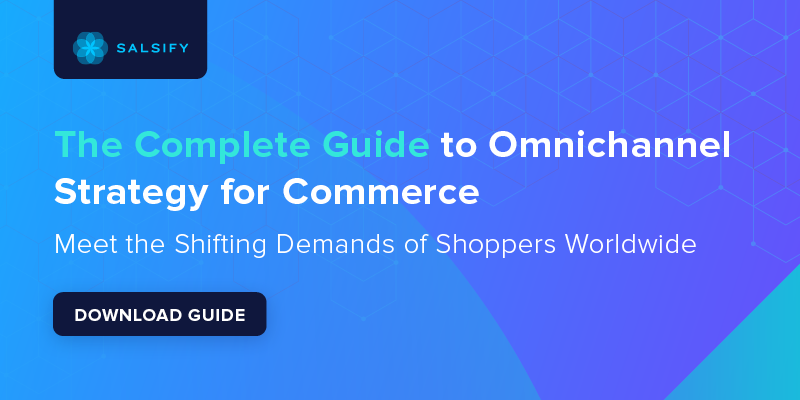How To Reach Shoppers With Channel and Customer Market Segmentation
Written By: Madeline Koufogazos
Want to connect with your customers in a more meaningful way but don’t know how?
Channel segmentation, which is the act of grouping customers together based on their similarities, is an excellent way to ensure that your marketing is finding the right audience.
Here’s a breakdown of channel segmentation, four of the most common types of consumer market segmentation, and how you could effectively organize your market and reach different sales channels.
What Is Channel Segmentation?
Channel segmentation is the process of organizing customers into groups based on their background, interactions with your brand, location, and interests, and tailoring your marketing tactics to match each group’s needs.
Four common types of consumer market segmentation include:
- Demographic
- Behavioral
- Geographic
- Psychographic
When done right, channel segmentation can improve campaign effectiveness and customer engagement because you’ve done the legwork of identifying and determining who your audience is and what they want to see.
4 Ways Brands and Retailers Can Best Organize Consumer Market Segmentation
Customers expect an omnichannel shopping experience across all of their favorite touch points, but you need to know what their favorite touch points are in the first place.
Channel segmentation and consumer market segmentation allow you to connect with your consumers on a deeper level and better understand their desires and needs. You’ll see them as three-dimensional people rather than data points.
1. Demographic Segmentation
Demographic segmentation is the act of categorizing customers by identifiers such as age, gender, income level, and marital status.
Age
Age can play an important role in determining a customer’s interests: It’s likely that teenagers and adults will have different preferences for content, especially how the content is delivered.
For example, TikTok attracts users of varying backgrounds and ages, but it’s particularly popular with Generation Z, according to Statista. While Instagram is also very popular with Gen Zers, millennials slightly outrank them on the app, says Statista.
Segmenting consumers for your social media or social commerce strategy will ensure that the content your consumers are interacting with is age-appropriate and appealing.
Gender
Gender segmentation can be useful when well executed, but it’s a delicate balancing act. If you lean too far in one direction, you can enforce outdated stereotypes. Focus less on creating “blue” or “pink” products and more on the product value for the user.
Income Level
Income level is crucial to consider when segmenting your customer base because your customer’s budget affects their spending habits. You don’t want to market high-end luxury products to the wrong audience, for example.
Knowing how the economy impacts purchasing decisions is also critical. Salsify’s “2023 Consumer Research” report, which offers a consolidated view of its surveyed countries, reports that rising costs have had a significant impact on how consumers shop. Sixty-two percent of shoppers say that low prices influence where they choose to shop online, and 96% of shoppers say that rising costs have influenced how they shop in general.
Marital Status
A married customer may approach shopping differently than a single customer. For example, a married parent of three young children would likely take their family into consideration in their shopping habits, whereas a single customer who doesn’t have children is more likely to shop for themselves.
Consider marital status when segmenting customers into different holiday marketing campaigns. Marital status is especially important to take into account on a holiday like Valentine’s Day, for example.
2. Behavioral Segmentation
Behavioral segmentation often groups customers together based on their previous interactions with your brand, website engagement, and purchase behaviors.
Previous Brand Interactions
Analyze the customer’s previous interactions with your brand. Are they a repeat or loyal customer? Do you offer a subscription program that they’re part of? Do they only purchase once a year?
Segmenting customers based on their interactions with your brand will allow you to better connect with those who are already fans and offer them benefits that will keep them loyal.
Salsify’s consumer research shows that 46% of consumers say that discounts or loyalty coupons keep them loyal to a brand. For those that aren’t frequent customers, draw them back in with deals they can’t resist.
Website Engagement
How often does a customer interact with a specific product on your website? Do they return to it often, only to abandon their cart? Do they leave reviews for your products?
Knowing how a customer engages with your website will allow you to better customize their website experience. For example, you could display messaging that says “Welcome back, {NAME}” every time they log in to their account.
Purchase Behaviors
Segmenting customers by purchasing behavior will ensure that you’re publishing content on the right channel at the right time, where they’re most likely to interact with it.
For example, you could promote a limited-time offer on Instagram late at night to capture the attention of night owl customers who make purchases when they can’t fall asleep.
You should also account for customers who do extensive research before purchasing an item.
Salsify’s consumer research found that 62% of shoppers say they conduct research on a company’s reputation for product quality before they consider buying from them.
Consider working with a social media influencer to increase your credibility. Since 61% of consumers trust influencer recommendations, according to Influencer Marketing Hub, it would be an excellent way to promote your brand and product quality.
3. Geographic Segmentation
Geographic segmentation breaks customers down into groups such as culture, climate, location, language, and time zone.
Culture
Honoring customers’ cultures shows that your brand cares about them on a more personal level. For example, if you’re a food brand marketing to a culture that fasts on certain religious holidays, you need to be sensitive to the needs of your customers.
Climate
If your product or service is weather-dependent, climate is an important factor to consider.
For example, while June marks the beginning of warm summer weather in Europe and the U.S., it also means the beginning of winter for Australia. If you’re opening a clothing store in Australia right before June, you’ll want to display winter clothes, even if your European and U.S. stores are selling summer clothing.
Location
Knowing the preferences of shoppers in the countries you’re marketing to is crucial.
For example, Salsify's “2023 Shopper Research,” an interactive country-by-country breakdown of its annual global consumer research, highlights that 51% of shoppers in Australia, 64% of shoppers in France, 65% of shoppers in Germany, 72% of shoppers in Great Britain, and 85% of shoppers in the U.S. are most likely to buy a product on a retail site.
Conversely, 60% of shoppers in Germany, 62% in Great Britain, 69% in the U.S., 72% in Australia, and 79% in France are most likely to buy a product in-store.
Australia has a noticeable difference in consumers who are most likely to buy online (51%) versus those most likely to buy in-store (72%). Based on this information, your brand may decide to open physical stores in Australia to appease customers who prefer an in-store experience.
Language
Do all of your customers speak the same language? If not, hire translation services to ensure that you’re reaching them in their preferred languages.
Time Zone
Schedule your marketing campaigns around time zone differences. Make sure that you’re posting at the peak engagement times in each location.
4. Psychographic Segmentation
Psychographic segmentation often categorizes customers by their personality, values, lifestyle, and interests.
While demographics give you an idea of your customer’s identity, psychographics gives you a more layered perspective of their interests.
Keep in mind that demographics and psychographics don’t always match up. Just because someone falls under one demographic doesn’t mean they’ll match the same psychographics as everyone else in their group.
Personality
No two customers are exactly the same, but some will share personality traits such as outgoing, introverted, risk-averse, and risk-takers.
Once you know their personality, determine what kind of marketing will work best for them. Do they engage more with direct, concise messaging? Or would they respond better with a creative, engaging approach?
Values
What’s important to your customer? Do they value sustainability? Salsify’s “2022 Consumer Research” report shows that 31% of shoppers in Great Britain, 33% in the U.S., 44% in France, and 53% in Germany check product packaging and recycling information before making a purchase. Find out what your customers value and make sure to highlight it in your marketing.
Lifestyle
Are your clients active outdoors? Or is entertaining at home more their speed? Segmenting your shoppers based on their lifestyle choices will show that you understand how your products will enhance their lives and add value.
Interests
What are your customers interested in? If they’re interested in sports, for example, consider releasing a TV ad during a widely watched event like the Superbowl or a more niche event such as a golf tournament event to capture their attention.
How Can Brands Use Content To Reach Different Sales Channels?
Creating a buyer persona, personalizing content, and offering a custom experience are three of the best ways for brands to reach different sales channels.
1. Create a Buyer Persona
Creating buyer personas, or a mostly fictitious profile of an ideal target customer, will allow you to determine your ideal customer’s demographics, behaviors, personality, and more.
For example, maybe your ideal customer is a young professional in their mid-thirties who enjoys going to the bar with friends after work and hiking on the weekends. You can cater to their interests by including lifestyle images or videos on your social media accounts that depict people around their age participating in their hobbies.
2. Personalize Everything
Customers expect personalization, and channel segmentation is the way to deliver it to them.
Salsify’s “2022 Consumer Research” report found that 70% of U.S. shoppers are more likely to buy if there are personally relevant images, videos, text, and reviews on a product page.
You can deliver personalization in various ways. Ensure that they see blogs or products they see on the front page of your website based on their previous interactions with your website. Send them emails that ask them if they’d like a discount on the product they’ve been eyeing.
3. Offer a Custom Experience
Makeup retailer Sephora does an excellent job customizing customers’ experiences by offering quizzes that will match them with products based on their preferences and needs.
The company also offers a Beauty Insider program that categorizes buyers into Insider, Rouge, and Very Important Beauty Insider (VIB) levels based on how much they purchase during the year. Sephora then offers different perks, sales, and content based on the customer’s level of engagement.
Channel Segmentation Will Help You Reach Customers
Determining your customers’ backgrounds, behaviors, locations, and personalities with customer market segmentation will help you offer an omnichannel shopping experience that successfully provides them with the content they desire across their favorite touch points.

GUIDE: The Complete Guide to Omnichannel Strategy for Commerce
Download this guide for actionable insights into creating an effective omnichannel commerce strategy that will help you connect with customers in meaningful ways.
DOWNLOAD GUIDEWritten by: Madeline Koufogazos
Madeline Koufogazos (she/her) is an editor and writer at Salsify, based out of Boston. She enjoys sharing her insights on consumer trends and behaviors, commerce, media, pop culture, and travel.
Recent Posts
The Rise of Reddit? What Brands Should Know About Reddit Ecommerce and Its Impact on the New AI-Powered Buying Journey
New Consumer Research: How Will Shopper Spending Habits Change in 2026?
How Frequently Do Retailer Requirements Change — and How Can Brands Keep Up?
Subscribe to the Below the Fold Newsletter
Standing out on the digital shelf starts with access to the latest industry content. Subscribe to Below the Fold, our monthly content newsletter, and join other commerce leaders.

.svg)